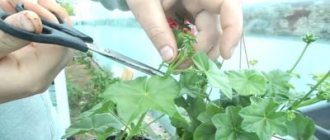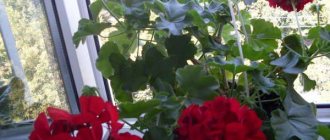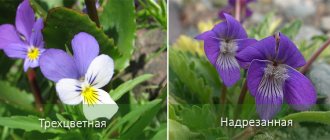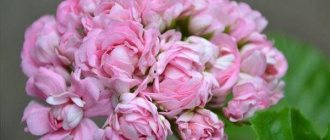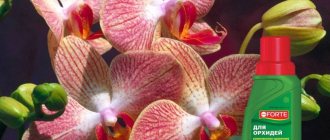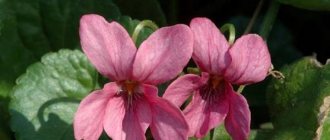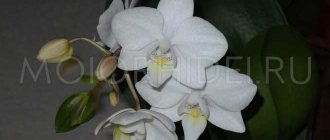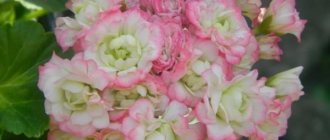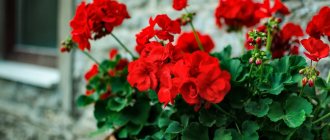Botanical description, history and price
Pelargonium Angel (Angel pelargoniums) is a plant that appeared as a result of crossing curly and royal species , from which it got dense foliage and medium-sized flowers. This is a fairly old variety, bred at the beginning of the 20th century.
Angelic pelargonium got its name from the word Angeline - in honor of the first variety of the royal subspecies. All varieties of Angel pelargonium available today are hybrids of one or another parent plant. This flower is also called viola pelargonium, or Viola geranium, due to its pansy-like flowers.
A distinctive feature of this species is its ampelous growth, like royal bushes. This type of growth is characterized by downward rather than vertical branches that hang over the edge of the pot.
In a flower shop, pelargonium of this type can be bought for 250 rubles.
Royal pelargoniums (Regal)
The name Royal Pelargoniums is adopted in relation to this group of hybrid pelargoniums in the UK, according to the botanical classification it is domestic pelargonium (Pelargonium x domesticum), while in Germany the name grandiflora pelargonium is more common, after one of the parent species - Pelargonium grandiflorum.
Royal pelargoniums are characterized by woody shoots at the base, evergreen coarse-toothed, heart-shaped foliage, cup-shaped, folded upward, like the second parent species of this group - Pelargonium cucullatum. The foliage is large and beautiful, its shape ranging from entire heart-shaped to varying degrees lobed, with large, unequal teeth along the edge. Lush inflorescences-umbrellas consist of a few but large, up to 5 cm in diameter, flowers, often reminiscent in general terms of the flowers of simple or double petunias. Due to branching, there are quite a lot of them on the plant, so the flowering is abundant and colorful, from May to August-September. The color of the petals ranges from white to black-red, through the entire spectrum of pink, red and purple tones. Often the petals are decorated with spots or strokes of a contrasting color, corrugated, fringed or torn edges. They, like other pelargoniums, are characterized by pubescence of foliage with glandular hairs, which determine their roughness and the presence of a characteristic geranium odor when touched or rubbed in some varieties (many varieties have odorless leaves).
These pelargoniums feel good on the windowsill only if they are kept cool. In summer, plants prefer to spend time outdoors - for this it is better not to plant them in open ground, where the flowers can be damaged by rain, but to display them in a container in a protected place. The pot should not be large in volume, since highly developed and fattening plants bloom worse. In August, the plants are cut out and kept cool for at least 6 weeks, after which a light and cool window sill is selected for the plants - this is the key to good, abundant and early flowering at the beginning of next summer.
This pelargonium can rightfully be called the queen of window sills, but even in the middle of the last century it was known as a modest “village beauty” that adorned small European settlements. Today this is the second most numerous and commercially available group after zonal pelargonium - hybridizers have been working with it since 1800, and now there are large producers of new hybrid varieties, of which many have already been bred. Here are some of them.
Description of appearance and features
In appearance, angelic pelargoniums resemble royal pelargoniums in miniature . They usually bloom profusely and feature many flowers against a background of dense double foliage. Angel pelargoniums are not tall, but they are hardy and grow slender and lush. At the same time, their foliage has a fragrant smell, reminiscent of lemon aroma. Violet pelargonium flowers come in a variety of shades, such as pink, purple, white, two or three colors, with a border around the edges.
Distinctive features of flowers of this species are their light-loving nature and resistance to dry weather, as well as ease of care and relatively fast growth rates. But to obtain a beautiful and abundantly flowering plant, it is necessary to provide proper care for it. Typically, the flowering period is about 9 months.
As mentioned above, angelic pelargoniums hang down when growing, so they are well suited for growing in hanging structures and garden flowerpots. It should also be noted that these pelargoniums bloom best in groups, so it is better to plant them 5-7 pieces in one container. If the flower grows in the sun, you don’t even need to trim it, since Angel pelargonium does not lose its shape and maintains a neat appearance.
Advantages and disadvantages
The advantages of violet pelargoniums include:
- beautiful appearance;
- easy care;
- compactness;
- excellent smelling leaves;
- long flowering period, which lasts about nine months. With due diligence, you can extend it for a whole year.
These flowers will be an excellent decorative decoration for your home, because they have no flaws. However, they, like any indoor plants, need proper care. Otherwise, the geranium will begin to hurt and wither.
Pelargonium variety Angel is a beautiful flower that will be an excellent addition to any gardener's indoor garden.
grow-me.ru
Common varieties and their photos
To date, flower growers have not developed many varieties of Angel pelargonium, since this species is a hybrid . But breeders have developed several beautiful forms, of which the most popular and beloved by all are Angel Viola and Angel Orange.
Viola
Angel Viola is a small neat bush that pleases with abundant flowering all summer long. The flowers of the plant are bright pink and have crimson spots on the petals. The leaves of this plant exude a pleasant lemon aroma that helps improve well-being.
Orange
This variety of angelic pelargonium (Angeleyes Orange) is distinguished by its unpretentiousness and abundant flowering. Angel Orange flowers have a bright pink-orange color, their center is burgundy-brown, and there are burgundy veins throughout the petal. The beautiful openwork leaves of the plant make it decorative. In addition, such bright flowers will be an excellent decoration when decorating garden pots or trellises, and will also give a spectacular look to any room.
Uniques
Most of the unique varieties have been known since the mid-19th century; radiant pelargonium (Pelargonium fulgidum) and its varieties were presumably used for hybridization. These are rather tall evergreen bushy pelargoniums with woody stems, flowers collected in small heads, reminiscent of royal pelargoniums, but smaller in size. They differ from them by more deeply irregularly dissected leaves, sometimes two-colored, with a pungent spicy odor. The flowers are without fragrance, predominantly red, with dark spots and streaks, less often the color is pink, salmon or white.
This is one of the easiest groups of pelargoniums to grow. In summer they withstand rainy weather well. In autumn, the plants are cut off above the woody parts and transferred to the windowsill. Cuttings root more slowly than those of royal pelargoniums.
This group of varieties is not very numerous, so these are truly unique pelargoniums. Some varieties have survived from the Victorian era, such as Paton's Unique, known since 1870.
- Copthorne - up to 50 cm in height, with leaves quite deeply dissected into lobes, which have a spicy aroma. Light clusters of lilac flowers with purple markings on the upper petals rise above the plant.
- Crimson Unique - up to 50 cm tall, deep wine-colored flowers with a black spot and veins at the base of the petals. The leaves are dark green.
- Mystery - up to 35 cm tall, with rounded, velvety fragrant leaves and inflorescences of deep purple-red tones with an almost black eye and a network of dark veins on the petals.
- Paton's Unique - up to 50 cm tall. The leaves are grayish-green, deeply cut, five-lobed, with an apricot aroma. The flowers are pink with a white throat and chestnut-colored veins.
- Pink Aurore - 30-40 cm tall, with dense inflorescences of large dark pink flowers with maroon spots on the upper petals. The leaves are green, crinkled, deeply lobed.
Photo: Nina Starostenko, Rita Brilliantova
www.greeninfo.ru
Where and how to plant?
- If you plant pelargonium seeds, it is better to plant them in the middle of winter in small containers with peat or a 1:1 mixture of peat and sand.
- Then the planting should be treated with a substrate and covered with glass.
- After emergence, it is necessary to maintain soil moisture and an optimal temperature of 20-22 degrees.
- If you brought geranium from the store or replanted it, then for this you need to prepare the optimal soil composition.
- In addition, regular pruning and watering are necessary. It is necessary to take into account that excessive watering can even lead to the death of a houseplant.
Lighting and location
Indoor angelic pelargonium should be grown on well-lit windowsills. In addition, the pot for growing it should be small. In the shade, the plant only grows, but may not produce buds.
Reference. Pelargonium Angel is prone to ampelous growth in the shade and compact growth in the sun.
Soil requirements
To plant and replant angelic pelargoniums, you can buy soil from flower shops that is suitable for geraniums and other indoor flowers. You can also use ordinary soil mixed with peat. Before planting, you should carefully check the soil for the presence of insect larvae and other pests. If purchased pelargonium is replanted, then you should prepare the soil with a composition of:
- turf;
- sand;
- humus;
- leafy soil.
You can also use a nutrient mixture for pelargoniums , which is sold in stores.
The best varieties
Among these pelargoniums, the best varieties are distinguished:
- Orange The flower has a rich orange color with a salmon tint. Juicy small green leaves, framing this bouquet, add contrast to the composition and complete the natural masterpiece. Hanging shoots and leaves of Orange will become an unrivaled decoration on elegant wicker trellises in flowerpots and other hanging flowerpots.
- Viola. Its flowers resemble violets. The presence of crimson and pink flowers gives the variety a special tenderness. Geranium leaves are distinguished by their leaves, which have a sweetish lemon aroma. The leaves have multiple small hairs on the surface, which is why they have a velvety feel to the touch. This variety likes to overwinter in cool conditions; a temperature of about 15 °C is quite suitable.
- Fallen. Dwarf geranium. It has strikingly bright pink large flowers with denticles at the ends, strewn with small crimson specks. The leaves are dark green, consisting of five “paws” (reminiscent of maple), in the middle of which there is a purple spot.
- Swedish. This variety has strict two-color flowers. The dark burgundy color of the petals is framed towards the edge with a white braid. White color is also present in the middle. These are quite large flowers from the Angels collection.
- Fragrant pelargoniums represent a unique group of varieties whose leaves exude amazing aromas of menthol, lemon, pineapple, apple, peach and other fruits.
- Zonal pelargonium surprises with lush, lush flowering. In terms of the shape of the flowers, zonal pelargoniums are double, as they have more than eight petals in the inflorescence. They have green carved leaves with red-brown edges.
Home care
It should be noted that for abundant flowering, pelargoniums need a cool winter, about 10-12 degrees Celsius. And during the period of active growth, they need to be fed with various fertilizers, like any flowering indoor plant. The presence of phosphorus and calcium, as well as a moderate nitrogen content, is especially important in the fertilizer. In addition, flowers need to be watered in moderation, maintaining soil moisture, and be sure to remove dried flowers.
You should not water the plant with spray fertilizers - this is harmful to the buds. In order for Angel pelargonium to bloom and develop, all that is required is good lighting and optimal air temperature. In winter, if there is a lack of natural light, it is necessary to give it additional light with fluorescent lamps. This condition provides the plant with compactness and abundance of flowering during growth.
Pelargonium violota 'Angel'
Anyone who has known me for a long time knows that I am rather indifferent to flowering indoor plants.
Maybe because they don’t want me to bloom, or maybe the spines of cacti are more attractive to me))) But relatives and friends do not lose hope that one day I will plant a garden on the windowsills and periodically give me flowering plants. Recently I even wrote that for my birthday I received several indoor flowers - spathiphyllum, callas, bromeliads. Something is blooming, and something has happily bloomed and died((((. And here is another gift. Friends went on a long business trip and decided to give me a gift in advance for March 8th. And they were inspired by the pelargonium of my mother - Zvezdchataya (given it to her on It was my sister’s birthday and she bragged about it by sending photos.) They didn’t find exactly this variety, but they bought Angel viola pelargonium.
Pelargonium
Pelargonium has never been my favorite. My mother and grandmother grew it, but it didn’t take root with me. And I didn't like the smell of it. But as they say - beauty is a terrible force!!! The blooming pelargonium simply delighted me. Before this, I had only seen such a bright and unusual coloring on Svetlana Doronicheva. This is where they grow and bloom all year round! I always looked at her photographs and thought - buy, not buy... And here is a gift.
Ads by
Description of the plant
Pelargonium Angel appeared by crossing two varieties - royal and curly geranium and, like the entire geranium family, comes from Africa.
The plant is a bush 40-60 cm high with a tree-like trunk and fluffy hairs along the entire length of the stems with a characteristic lemon smell.
Flowers and buds The buds are elongated and have sharp tips that resemble the buds of violets or violas. When opening, the flower is painted in two or more tones - the upper ones in one color, the lower ones in another. This is a distinctive feature of this species. Flowers can be white, pink, burgundy, lilac.
Oh, what beauty!
Growing conditions
Loves:
- warm,
- good lighting,
- temperatures not higher than +25°C.
Does not love:
- temperature below +8°C,
- drafts,
- direct sunlight.
Watering and fertilizing
In summer, pelargonium should be watered frequently: two to three times a week.
The water should be warm and soft. But in winter we reduce watering. We wait until the top layer of soil dries. We feed pelargonium once every two to three weeks from spring to late autumn. Universal fertilizers for flowering indoor plants.
Transplantation, planting and propagation
Pelargonium propagates by seeds and cuttings.
But cuttings are more common and quick. A cutting up to 10 cm long, with 2-3 leaves, is placed in soil consisting of a mixture of sand and peat. After 2-3 weeks, roots appear and pelargonium takes root. For this type of pelargonium, a special soil mixture for geraniums or a mixture of turf, peat and sand is desirable. Pelargonium needs to be replanted into a pot several centimeters larger than the previous one. If the volume is large, the plant will sprout and flowering will stop. If less, there is a high probability of root rotting. Before transplanting, the geranium is filled with water and carefully transplanted along with the soil into a new pot filled with expanded clay and soil mixture. Then we fill the voids between the flower and the pot with the necessary soil. Watering for 4-5 days.
Features of cultivation
It is advisable to prune pelargonium twice a year, forming compact bushes and removing dry shoots.
In winter, it is best to keep pelargonium in a cool room, thanks to which buds will form better next year. In addition to indoor cultivation of pelargonium, experts recommend planting it in outdoor pots. Then you need to plant several bushes for lush flowering. Each bush seems to be competing - who will give the most flowers!
You can decorate both your yard and your home with such beauty! This is the kind of indoor flower I got this year. For now it blooms in lush colors on a shelf in the room, but after looking at this beauty, I’m thinking of planting it in a pot on the veranda. I think it will be beautiful and bright!
Common diseases and pests
Great harm to Angel pelargoniums is caused by gray rot , which appears in the form of a gray coating on the leaves. The reason for its occurrence is excessive dampness and poor ventilation of the room. To prevent this disease, it is necessary to provide enough space between plants and promptly clean the plant from dry twigs and leaves.
For the same reason, the plant undergoes stem rotting, which manifests itself in the appearance of dark spots at the base of the latter. Usually this disease cannot be cured, so at least the top cuttings need to be saved.
Like many indoor plants, Angel pelargonium is susceptible to various fungal diseases. For prevention, it is necessary to treat the plant with special solutions.
Also one of the common pests is whitefly, which appears in the form of small white spots or larvae on the bottom of the leaves. When purchasing a plant, you should pay attention to the leaves of pelargonium. Also, before bringing a plant from the garden into the room, it is necessary to treat it with insecticides.
Planting and Transplanting Pelargoniums
The pot for pelargoniums is chosen to be small - exactly the size of the root system . The average pot size for a standard bush is 10 cm in depth and diameter. This promotes uniform nutrition of the plant’s root system and prevents stagnation of moisture in the soil. It is better to take clay pots.
A drainage layer of 2-3 centimeters must be laid on the bottom.
Pelargonium needs to be transplanted when roots appear from the drainage holes.
A new pot is taken a couple of centimeters larger in diameter and depth. If the pot is not new, it is washed well with laundry soap and treated with a solution of potassium permanganate.
Transplantation is carried out in a gentle way - by transshipment , without destroying the earthen ball with roots. At first (a couple of days), the transplanted plant is not watered and kept in partial shade.
You can plant several pelargonium bushes in large pots. If the plants are of different colors, then during flowering this bush will look especially decorative.
Features of reproduction
There are several ways to propagate Angel pelargonium - by seeds, cuttings and dividing the bush. Cuttings are considered one of the most productive methods of propagation, since it is this method that guarantees the preservation of the varietal characteristics of the plant.
Cuttings
Angel pelargonium cuttings can be selected at any time of the year, but it is better to do this at the end of winter - beginning of spring, or after flowering has ended.
- Cuttings should be taken from young and strong plants. From Pelargonium Angel you need to cut cuttings 2.5-3 cm long, making an oblique cut at the bottom.
- This end can be treated with charcoal, preventing it from rotting.
- You need to stick the cuttings into the prepared substrate and cover them with a jar or plastic bottle.
- In this case, it is necessary to maintain a temperature regime of about 22 degrees.
- In about 1.5-2 weeks, rooting should occur.
- In addition, the cuttings can be placed in a container of water and wait for the roots to appear.
- After this, the cuttings should be transplanted into a container with soil.
Unlike Pelargonium Angel, other species of this wonderful plant simply amaze the imagination with the number of varieties bred. Particularly popular among them are: Rococo, Andrea, Zonartik, Richard Hudson, Clara Sun, Salmon, Anita, Prince Gustav, Viva and April Snow.
Pelargonium Angel is a wonderful decorative addition to any garden or room. With proper care, it will delight its owner with abundant flowering and fragrant aroma. Its positive qualities include beauty, long flowering period, medicinal properties and ease of care.
Pelargonium zonal or bordered (Pelargonium zonale)
All kinds of hybrids and varieties of this type of indoor geranium, as in the photo, grow well in the house, on balconies and even in city flower beds. This is the undoubted leader in popularity and number of cultivated varieties, of which there are about 75 thousand today.
When describing geranium varieties, in the photo, and in the names of plants, the following gradation is used according to the number of petals in the corolla:
- non-double flowers consist of five petals - Single;
- semi-double flowers have from 6 to 9 petals and are designated Semi-Double;
- double geranium flowers consist of 8 or more petals - Double.
Terry varieties are sometimes called peony geraniums, which is somewhat incorrect. There is no such group of plants in the internationally recognized classification.
Zonal geranium flowers differ not only in splendor and size. Long gone are the days when only red geraniums were displayed on the windows.
Depending on the variety and variety, pelargonium pleases the eye with umbrella-shaped inflorescences of all shades of pink, cream, burgundy or crimson. It is not uncommon to have plants with white, multi-colored and even yellow corollas, as in the photo of a geranium variety called First Yellow Improved.
But these are not all the strengths of indoor geraniums.
Flower growers pay special attention to varieties with a flower shape that is uncharacteristic for the species.
Rosaceae (Rose-bud Zonal pelargoniums)
An example is a pink-shaped geranium, as in the photo, with double, showy flowers, reminiscent in structure and appearance of miniature English roses.
This variety of indoor geranium, its name and photo of flowers have been known in the world since the century before last. The first information about plants was published in the Bulletin of the Royal Horticultural Society of Britain in 1876. But in our country, rosaceous varieties have not yet become widespread and are found only in the collections of the most enthusiastic flower growers.
Tulip-shaped indoor geraniums (Tulipe-bud pelargonium)
A century later, flower growers received domestic geranium plants with flowers that, even in full bloom, do not open, remaining in the bud stage.
As a result, this indoor geranium shown in the photo was called tulip-shaped. The variety began with a spontaneous mutation, and the few varieties and hybrids of tulip-shaped geranium that exist today sometimes try to return to their natural form when grown or propagated.
Star indoor geraniums (Stellar Zonal Pelargonium)
In the middle of the last century, Australian flower growers managed to obtain indoor geraniums with an original corolla shape, unlike the varieties that existed before.
Currently, flower growers have at their disposal varieties and hybrids not only with simple and double flowers of all shades, but also star-shaped pelargoniums with bright multi-colored foliage.
Cactus-shaped house geraniums (Cactus Pelargonium)
Cactus-shaped geraniums obtained at the turn of the 20th century are extremely rare today. A characteristic feature of these plants is large flowers with narrowed, sometimes needle-like petals, giving the corolla a sloppy, disheveled appearance.
Carnation Pelargonium
Indoor geraniums, in the photo, amaze with the variety of flowers, colors and types. One of the most unusual is the carnation variety of zonal pelargonium with serrated petals, giving a resemblance to carnation flowers.
The benefits and harms of pelargonium
Pelargonium is undoubtedly a medicinal plant used in medicine. Pelargonium has a powerful antimicrobial effect. Broad-spectrum essential oil is produced from pelargonium and geranium The main treatment profile is nervous diseases , insomnia. But pelargonium also helps with other diseases. It is better not to self-medicate with the plant; in all cases, consult a doctor.
At home, the smell of geranium helps relieve headaches and strengthens the nervous system . But, since the smell is quite intense, it can cause the opposite effect in sensitive people and, conversely, cause headaches. This must be taken into account when purchasing a flower, having previously determined the reaction of your body.
